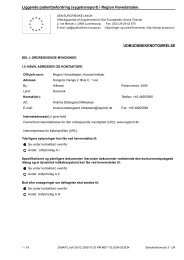Territorial Review Copenhagen - Region Hovedstaden
Territorial Review Copenhagen - Region Hovedstaden
Territorial Review Copenhagen - Region Hovedstaden
You also want an ePaper? Increase the reach of your titles
YUMPU automatically turns print PDFs into web optimized ePapers that Google loves.
244<br />
be most important to urban areas: there are indications that variations<br />
between cities in the performance of established local firms make the largest<br />
contribution to their overall success or failure (Cheshire and Gordon, 1998).<br />
Policies that can significantly affect this will have the most potential to<br />
contribute to local success.<br />
Many cities that are attractive to firms are not necessarily attractive to<br />
households and vice versa. This can be implied from Gabriel and Rosenthal<br />
(2004), who constructed and analysed an annual panel of quality of business<br />
environment and quality of life measures for 37 cities in the United States<br />
from 1977 to 1995. The correlation between quality of business environment<br />
and quality of life in their study is only about 5%. These findings suggest<br />
that firms and households prefer different cities, consistent with the two<br />
groups‘ different goals. With the ageing of the baby boomers, cities are<br />
increasingly sensitive to retirees‘ choice of location. Cities most likely to be<br />
dominated by retirees are those that are less attractive to firms, and more<br />
generally, those cities that are attractive to households but that have low<br />
housing prices. Retirees tend to seek out cities where local attributes are<br />
capitalised into lower wages rather than higher land rents.<br />
Competition between cities can be wasteful, for example in the case of<br />
policies to attract inward investment that could yield benefits only for those<br />
directly involved in development or new sites, or for non-local firms, which<br />
can play off contending areas against each other. Some of these policies will<br />
end up incurring costs of one kind or another that could negate the gains the<br />
community can expect to make. A more sustainable choice is to identify<br />
distinctive strengths that can be developed over the medium to long term.<br />
One important distinction to make involves the extent to which a given<br />
policy is diversionary: that is, whether it influences the location of a<br />
particular activity rather than the overall productivity of resources (Cheshire<br />
and Gordon 1998). Strategies that are too localised will lead to unproductive<br />
competition between local units, with outcomes at best zero-sum across a<br />
wider area, the gains being balanced by losses. These are important reasons<br />
for focusing competition at the level of functional urban regions, rather than<br />
local areas.<br />
City collaboration can be a solution for wasteful competition. In many<br />
cases, the key for generating support for the concept of collaboration<br />
between cities is the identification of a shared competitor. By combining<br />
two or more cities‘ critical mass in terms of asset bundles, population,<br />
market catchment and economic output, collaborating cities seek to compete<br />
at the next level up in the urban hierarchy. Collaboration is more likely to be<br />
worthwhile for proximate cities where the potential exists to combine their<br />
existing economies to create a single economic space, similar to those of the<br />
largest cities. Increased mobility is often seen as the key to improving the

















